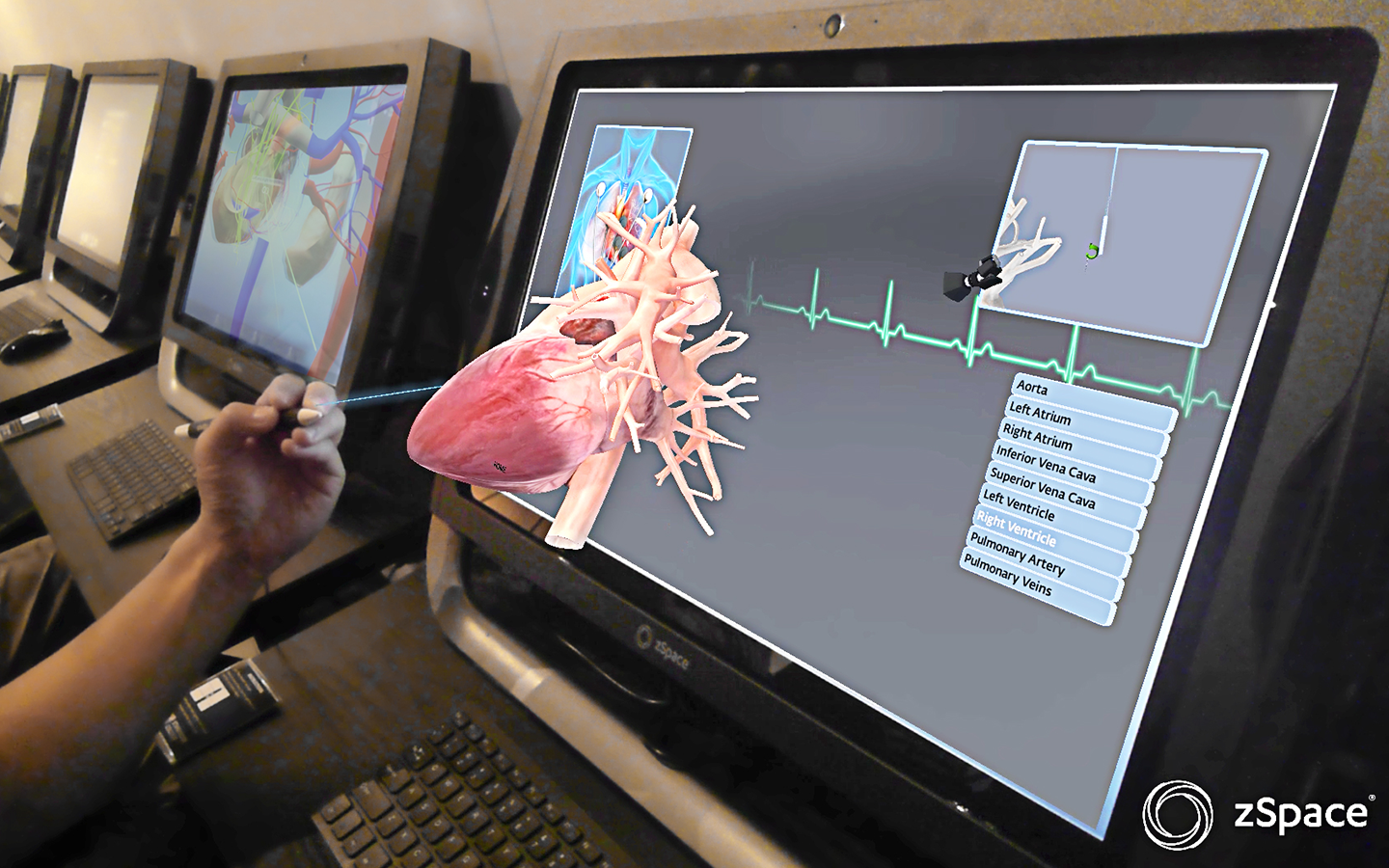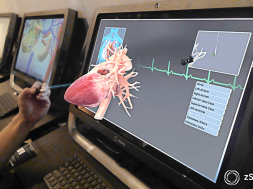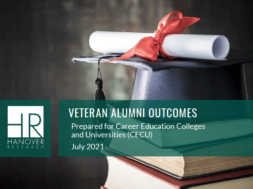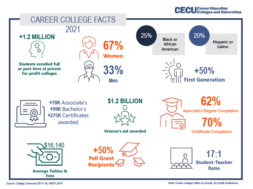
Healthcare Students Learn With Virtual Reality
Stanbridge University opens one of the largest virtual reality labs for medical training in the nation.
Written from an interview with Yasith Weerasuriya, President, Stanbridge University
If seeing is believing, Stanbridge University students are becoming true believers thanks to a new medical virtual reality technology adopted by the Irvine, California university.
Stanbridge, which officially became known as Stanbridge University on Jan. 1, has opened one of the largest virtual reality (VR) labs for medical training in the United States. The labs feature 18 zSpace® screen virtual reality all-in-one computers and a 3-D smartboard, as well as partner applications Cyber Science 3D™, Cyber Anatomy™, and Visible Body™ allowing virtual dissection of human and animal anatomical models.
As the 18th lab facility on campus, the Virtual Reality lab allows interaction with high-fidelity, virtual holographic 3-D models. Students can learn from more than 1,000 models of biological and anatomical structures ranging from a cell to a human or animal’s body and body systems.
Students in nursing, occupational and physical therapy, and veterinary technology programs at Stanbridge can, using a stylus and 3-D glasses, virtually ‘lift’ an object off the zSpace screen, manipulate and adjust to see it at different angles, and magnify for fine details.
They can also dissect layers and components of a model for a deeper understanding of tissue interconnectivity.
“Students also have access to the Smithsonian X 3D Explorer with thousands of 3D images. That allows students to get an internal and 3-D look at such animals and fossils including the Tasmanian tiger or the wooly mammoth,” said Stanbridge University President, Yasith Weerasuriya.
Unlike the normal concept of virtual reality, which is a full immersion experience with a headset, this technology uses a stylus and 3-D glasses, allowing the cameras on the four corners of the monitor to track head movements so that it adjusts the viewing based on the positions of the users. That, in turn, allows viewers to move 3-D objects out of the screen into thin air!
While Stanbridge has posted videos of the new technology on YouTube, such as of a heart or dog at https://youtu.be/nnwjt6SpPKA or https://youtu.be/xFMfzBOsMz4 respectively, those videos don’t really give viewers the full experience. Once you pull it out of the screen, you can “…quite literally immerse yourself inside a human heart…,” said Weerasuriya. He recalled his first demonstration of virtual reality technology in February of 2016 and said the experience is “still vividly imprinted” in his mind yet today. “In that brief experience, we could imagine this as a tool to help students having difficulty in some of the toughest areas of the human body – whether it’s neurosciences for a graduate occupational therapy class or the endocrine system for undergraduate students in nursing – when you have that immersive, kinesthetic experience, it’s not like watching a video – you are immersed in and exploring the organ. It’s an extraordinary reinforcement to the visual learner. You cannot only pull those organs and body systems out of the whole animal in the instance of the veterinary classes, but you can dissect it. So you are doing a virtual dissection on the computer.”
Weerasuriya said they had investigated virtual reality for four years, but in the beginning, it was very expensive and required custom coding. However, as the technology improved and as more companies started creating new VR products, they found zSpace.
“They created Cyber Science and Cyber Anatomy, which is extraordinarily well suited for healthcare training institutions such as ours because that experience could be forded across all the different programs in nursing, occupational therapy, physical therapy, and to our amazement, the veterinary world because they had the ability to dissect a cat, a dog, even a dolphin. Before this, students would have to work with specimens and cadavers. Another example, if you are learning about dogs, imagine removing its skin, then the muscles and bones and then seeing the organs.”
Not surprisingly, Stanbridge’s faculty members were excited to work with the new technology. “Everybody is just wowed with it. It’s eye opening. It’s with the times. It’s exciting and everybody wants to use it,” he said.
“The hard work comes after the excitement. We wanted to make sure the VR lab was integrated into the curriculum,” he said. “Programs need to assess how to best use the VR models in their coursework and make sure there is value behind each assignment,” he explained. “A lot of the work comes not only in the creation of that infrastructure,” Weerasuriya said, “but subsequently to make sure once you get into the labs, the students have clearly delineated instructions for each class it is used in.”
“The easy part was building the lab and buying the devices,” Weerasuriya said. “The harder part is training the faculty and integrating the technology into the curriculum.”
“We had lots of training sessions for faculty with the technology representatives here,” Weerasuriya said. “Subsequently, we’ve also done training at various faculty or instructional meetings, as well as having staff work behind the scenes with the different programs.”
The VR lab first launched in August, and students started using it as soon as it opened. The cost for such a VR lab is about $7,000 to $7,500 per station. “We have open lab hours where students can come in when a lab assistant is present,” he said. “The next enhancement we’re doing for the lab is adding a 3-D printer that’s silent, so students can actually print some of the 3-D models directly from virtual reality.”
The lab is one part of Stanbridge University’s initiative to drive innovation and technology into the classroom. In 2015, Stanbridge launched the West Coast’s first Human Cadaver lab with synthetic human cadavers from SynDaver™ Labs and real human cadavers. The Veterinary Technology program also opened two fully-functional surgical teaching clinics along with the world’s first high-fidelity, canine patient training simulator for veterinary technician training. The Occupational Therapy program opened the first Driving Simulation lab in Orange County in 2014.
When it came to building the VR lab, Stanbridge knew it had to be accessible to as many students as possible. For example, a group of students in a nursing class can look at a heart in the Virtual Reality lab, another group can dissect a heart in the Anatomy and Physiology lab, and a third group can work in the Cadaver lab and look at what that heart looks like in a real human being.
While it takes hard work, Weerasuriya explained that it’s the students who ultimately need to provide feedback through consistent evaluation. “We truly expect that by the end of 2017 we are going to have measurable outcomes in the curriculum based on student surveys.”
What do the students say about this emerging technology? Citing responses from a student survey, students reported that being able to visualize and manipulate different parts of the anatomy was “awesome” and easier to understand.
While it’s too early to tell if the system has impacted student learning at Stanbridge, Weerasuriya said they are focusing on utilizing the lab with their Learning Resource Center, their tutoring system and their Student Services Department.
“All of the tutors have been trained to focus on students who are having difficulty, and to use virtual reality as an immersion experience to help them,” he said. If a student is struggling, Student Services work alongside tutors to ensure the student has the opportunity to use the VR lab during open hours in conjunction with tutoring from peers or faculty and other resources on campus.
“It’s far more visible in its impact when we look at the left end of the bell curve with students who are struggling,” he said. “We are retooling the entire resource system in Student Services to gear this as an additional utility to help those individuals who could use it most.”
Weerasuriya predicted that the future of medical training will have strong elements of virtual reality, but acknowledged it may take some time to get there. EdTech Magazine and Education Dive recently published several articles on virtual reality changing the classroom experience. “They did a comparison that shows just how far and in between virtual reality utilization is,” he said. “You can build a little cardboard virtual reality set with your phone, but to have a full-scale implementation that multiple students can actually use and that is integrated into the curriculum takes a lot more time and effort.”
Stanbridge University isn’t the only school currently using VR technology. Stanford University and the University of Wisconsin-Madison also use virtual reality in their teaching, and Weerasuriya said other colleges have visited Stanbridge because they plan to implement virtual reality training.
Still, the work needed to be successful in virtual reality training shouldn’t scare off other career schools, Weerasuriya explained. “Ultimately, virtual reality will benefit the student experience. It may take time for the momentum to build, but it is worth it when we can fulfill the need to infuse innovation and technology into the classroom. This will foster a solid foundation of core concepts for our future professionals.”
YASITH WEERASURIYA is president of Stanbridge University in Irvine, California, which focuses on healthcare training that leads to licensure. With more than 20 years of executive leadership experience in the education sector, Weerasuriya’s expertise includes specializations in the information security and fiber optic technology, business, allied health and nursing.
Founded in 1996, Stanbridge University offers specialized degrees at the Master, Bachelor, and Associate levels in the fields of Nursing and Allied Health. Stanbridge has an annual enrollment of over 1,300 students.
For each year from 2009 through 2015, Stanbridge has been named to the President’s Higher Education Community Service Honor Roll, the highest federal recognition a college or university can receive for its commitment to volunteering, service-learning, and civic engagement. In 2016, Stanbridge University was awarded the Gold Award for Excellence in Community Service from The California Association of Private Postsecondary Schools (CAPPS) for offering students quality higher education while simultaneously maintaining efforts to assist the local community. In 2013, Stanbridge University received the Accrediting Commission of Career Schools and Colleges (ACCSC) Community Service Award for outstanding outreach to the local and global community. Stanbridge University has been selected as a 2014-2015 School of Excellence by the ACCSC, and also received its 2015 Excellence in Student Services Award for creating a comprehensive student services program that enhances student achievement outcomes. Institutional Research & Evaluation, Inc., has named Stanbridge University one of America’s Best Technical Colleges for each year from 2009 through 2016.
Contact Information: Victoria Sauer // Media Department // Stanbridge University // 2041 Business Center Drive, Irvine, CA 92612 // 949-794-9090 // vsauer@stanbridge.edu // http://www.stanbridge.edu










